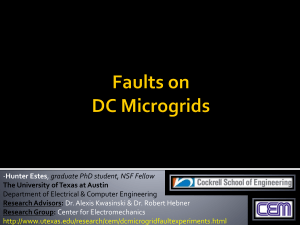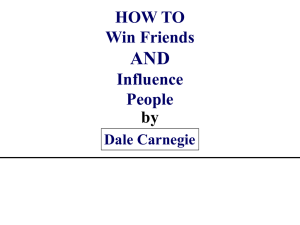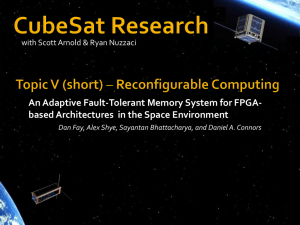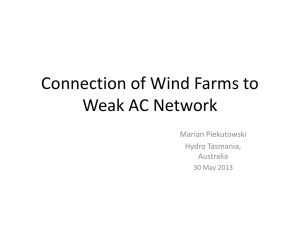Imaging fault geometry to learn about earthquake
advertisement
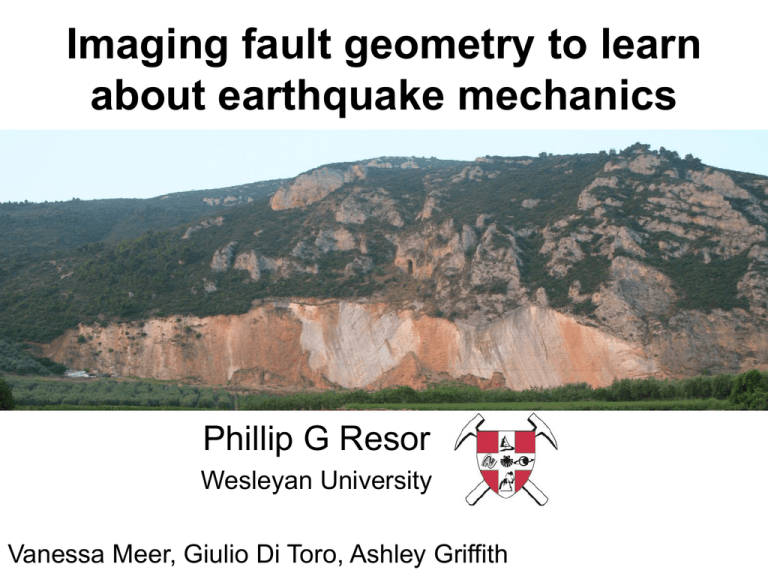
Imaging fault geometry to learn about earthquake mechanics Phillip G Resor Wesleyan University Vanessa Meer, Giulio Di Toro, Ashley Griffith Fault zones record an integrated history of fault slip Fault geometry and earthquakes: the seismological record Geometry and kinematics of exposed fault surfaces Looking inside rocks to see the frozen record of ancient earthquake Slip during earthquake rupture is heterogeneous Observed in surface ruptures Treiman et al., 2002, BSSA And inversions of seismological and geodetic data Mai and Beroza, 2002, JGR Slip heterogeneity is attributed to asperities and barriers Rheological: fault zone materials Shipton and Cowie, 2001, JSG Geometrical: Slip surface geometry Fault Analysis Group Fault geometry effects earthquake dynamics Km-scale discontinuities: earthquake initiation, termination, near fault stress Wesnousky, 2006, Nature Small-scale slip-perpendicular roughness: frictional properties, near fault stress Sagy and Brodsky, 2009, JGR Fault surfaces are characterized by a suite of slip-parallel features Corrugation axis Tool Track Slickenside lineations Gutter Hancock and Barka, 1987, JSG Fault surface roughness is fractal (self-affine) in nature linear decay of the power spectrum with slope of 1+2H dz -> lHdz 0≤H<1 Dixie Valley Fault Candela et al, 2011, BSSA dz dx -> ldx Power et al, 1987, EPSL TLS and other technologies have led to a renaissance in fault surface analysis Photo: Emily Brodsky Sagy et al, 2007, Geology Brodsky et al, 2011, EPSL Can we document effects of fault topography on fault kinematics? Resor and Meer, 2009 EPSL Data Collection Surface Morphology Striation Orientation Visualizing Surface Morphology Quantifying Morphology Slip parallel profiles Spectral Analysis Slip perpendicular profiles Resor and Meer, 2009 EPSL Incremental slip varies across the corrugated surface Resor and Meer, 2009 EPSL Fault normal and striation orientation are correlated across the entire exposure Striations Fault Normals Resor and Meer, 2009 EPSL Spherical correlation, significant at 99% probability Observations from creeping faults corroborate role of slip-parallel features Earthquake streaks on creeping faults are slip-parallel independent of local geology Rubin et al., 1999, Nature Summary of work on exposed fault surfaces Fault surface exhibit self-affine scaling over many orders of magnitude Faults evolve (slowly) toward smoother profiles in the slip direction Faults roughness perturbs fault slip direction But, these results are derived from faults from <~5 km depth Dynamic Rupture experiments reveal a number of lubrication processes Di Toro et al., 2011, Nature Pseudotachylyte (frictional melt) is the only unequivocal evidence of earthquake rupture velocities preserved in fault zones Pseudotachylyte-bearing fault surfaces are not widely exposed TLS and photogrammetry used to image 3D geomtry of fault trace Bistacchi et al, 2011, Pageoph Roughness of pseudotachylyte-bearing faults appears similar to small-slip faults Self-affine scaling over 3-5 orders of magnitude Smoother in slip direction Micro-roughness is critical to dynamic slip and melt lubrication Experiments reveal that weakening distance decreases with increasing normal stress CT scanning allows us to image micro-scale roughness of fault surface L05_07 core from extensional fault bend Griffith et al, 2010, JGR Extensional bend surface roughness due to fracture and wear Griffith et al, 2010, JGR L05_06 core from contractional fault bend Griffith et al, 2010, JGR Contractional bend surface roughness dominated by differential melting Griffith et al, 2010, JGR Conclusions and future directions Exposed fault surfaces exhibit self-affine roughness • Evolves with slip • Perturbs incremental slip direction • How is roughness generated? Ferril et al., 1999, JSG Sagy and Brodsky, 2009 JGR Pseudotachylyte-bearing fault traces also exhibit selfaffine roughness at larger scales • Fault zone geometry may be different • Micro-roughness is controlled by melting • Tie fault observations to experimental work Slow to High Velocity Apparatus (SHIVA), INGV “Rocks [melt] like butter in Rome” G. Di Toro Corrugation axes are correlated with long wavelength shape Corrugation Axes Fault Normals Spherical correlation significant at 99% probability

